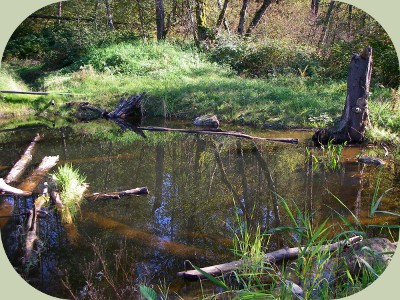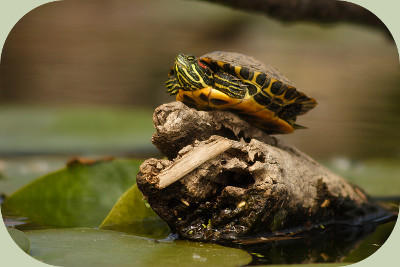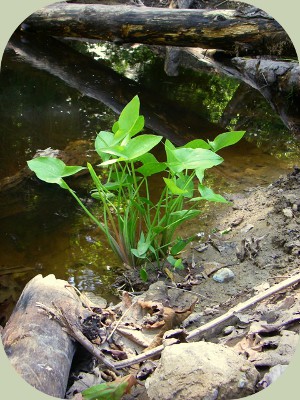Freshwater Ecosystems:
Ponds for Permaculture

Understanding what freshwater ecosystems are and how they function can help you better utilize a pond in the practice of permaculture, a system of sustainable design. Though fresh water only makes up less than 3% of all the water on earth, it is essential to human life and to the lives of countless other organisms. Keeping these systems healthy, properly working with them to grow food, process waste and create habitat vital to many types of animals is essential.
Freshwater Ecosystems: Pond Food Web
Ponds are complex systems of energy exchange between one kind of life form and another. A simplified version of this food web might go something like this:
- Rooted and floating plants which make food using sunlight and soil nutrients, provide food for herbivorous insects
- Likewise, phytoplankton provides food for zooplankton (which are tiny invertebrates)
- Both herbivorous insects and the zooplankton are eaten by small fish such as minnows
- Minnows are eaten by large carnivorous insects, turtles, and medium sized fish
- Medium sized fish are preyed upon in turn by large fish
- Large fish are eaten by top predators such as otters, osprey, herons and humans
- The bodies of all of these creatures upon death add nutrients back to the to the water and soil for both the phytoplankton and the rooted water plants
Of course, relationships in ponds are much more complicated than this and involve many more kinds of connections.
Observing Ponds
Whether you have a pond on your property or wish to create one. Find a pond somewhere in your general area and visit it regularly, you can learn a great deal of information about it from your own observations. Make regular records of your observations throughout the year and make sure to especially include the following categories: temperature of air & water, plant growth and decay, insects, amphibians and reptiles, fish, birds, mammals, water levels and flow, wind, weather, sunlight and human influences. It is vital to record this information as it can help you avoid or minimize negative impacts on the pond, as well as maximize possible growth of plants, fish or other resources. Remember to continue making observations and recording information after you make any changes to a pond.

Why Ponds for Permaculture?
Ponds are freshwater ecosystems that can be tremendously useful in permaculture practice. They can provide food, medicine, water storage, sun reflection (heat and light), filtration for waste, recreation and aesthetic value. A variety of edible species of plants can be grown in and around the margins of a pond, depending on the local climate. Many different edible fish species can be raised in a pond. If properly managed, a pond can also produce a great deal of food and materials which can be sold or bartered to create income.
Be More Prepared For Your Next Outdoor Adventure!

Don't leave without knowing these six essential survival skills. Our free survival mini guide reveals the strategies of:
- Shelter & fire to prevent the number one cause of death
- Obtaining clean water to avoid life-threatening dehydration
- Common wild survival foods and other critical skills!

Designing a Pond
Ponds can be designed to a variety of shapes and sizes, depending on need and available resources and on-site considerations. Some considerations to take into account are:
- Place your pond in a location that will naturally trap water from rain or a nearby flowing source
- Put in systems to help move water flow into your pond, but also to control outflow
- Outflow control is vital, especially if you stock your pond with a potentially invasive animal or plant species which might harm the greater local freshwater ecosystem
- Consider having multiple ponds that feed into each other
- Give the pond(s) a natural shape; make it irregular with a diverse edge and depth
- Have at least 1 deep portion in the pond so that fish and other animals can seek shelter during hot times or low water times
- Add plants that grow on the edge, in the water and totally submerged to create a natural gradient and add habitat for small animals
- Include large boulders, logs, snags, stumps and other features along the edge and submerged in your pond as habitat for fish (vital for small and baby fish) and other water life
- Plant species along the edge of your pond that provide a wide variety of functions such as: food for people, livestock, fish and wildlife, shade, bank stabilization, materials for utilitarian use. Such species might include: willows, cattails, wapato, pond lilies, lotus, wild rice, water cress, water chestnut and taro.
- Put up nesting boxes for species such as swallows and bats right over the water, as they can help control mosquitoes as well as add nutrients to the pond via their guano
- If you don't already have naturally occurring species that do so, consider stocking species in your pond that help process excess waste materials
Other Considerations
When intending to create a pond, it is vital to consider the health of this freshwater ecosystem. Remember that ponds are complex ecosystems, and keeping all parts healthy and functioning is important. Since ponds – no matter how small or large – are just a part of a much bigger working system, it is important to create one that will benefit the larger freshwater ecosystem in your area. Take special care to create habitat for local wildlife such as amphibians, native fish, birds and other life forms. A properly designed and implemented pond can be a productive source of food and materials for humans as well as a benefit to local life and your greater local freshwater ecosystem. Please contact your local fish and wildlife service and other conservation organizations for permits, special rules and laws as well as local considerations concerning ponds and pond life.
By the way, a big part of why we love homesteading & permaculture skills so much is because they are a natural extension of learning about wilderness survival (both fields are all about self-sufficiency and working with nature to satisfy needs). An understanding of survival not only helps you become a better permaculturist, it empowers you with life-saving outdoor skills to keep you safe when out in nature. Right now you can get a free copy of our mini survival guide here, where you'll discover six key strategies for outdoor emergencies, plus often-overlooked survival tips.
Additional Resources:
The Freshwater Biome - UC Berkeley
To learn more about permaculture, a design system for sustainable living, check out our Permaculture Courses.


About the Author: Filip Tkaczyk is a periodic guest teacher at Alderleaf. He also wrote the field guide Tracks & Sign of Reptiles & Amphibians. Learn more about Filip Tkaczyk.
Return from Freshwater Ecosystems back to Wilderness Articles
Is The Essential Wilderness Survival Skills Course Right for You? Take the "Online Survival Training Readiness" Quiz
See for yourself if this eye-opening course is a good fit for you. It takes just a few minutes! Get your Survival Training Readiness Score Now!

Grow Your Outdoor Skills! Get monthly updates on new wilderness skills, upcoming courses, and special opportunities. Join the free Alderleaf eNews and as a welcome gift you'll get a copy of our Mini Survival Guide.

 The Six Keys to Survival: Get a free copy of our survival mini-guide and monthly tips!
The Six Keys to Survival: Get a free copy of our survival mini-guide and monthly tips!
Learn more